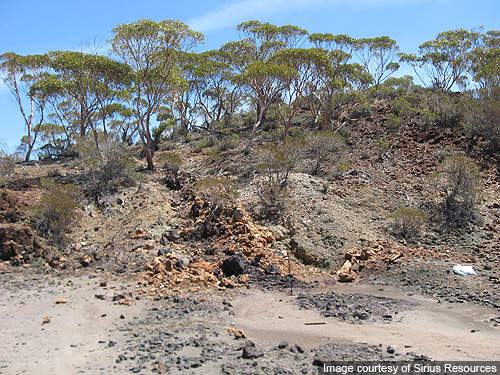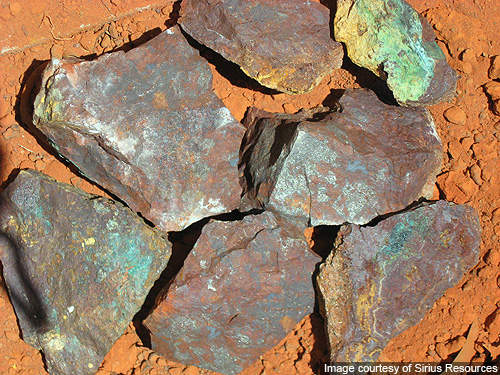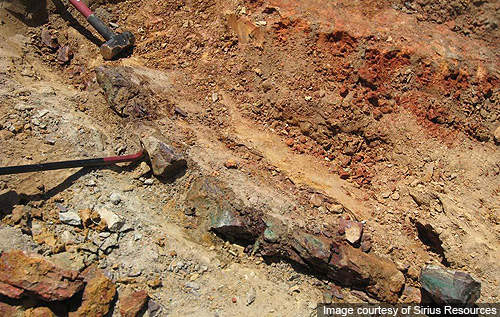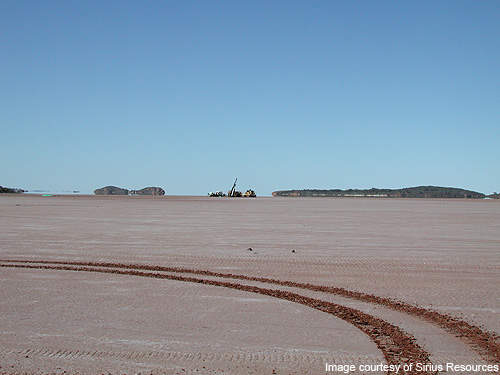The Polar Bear project is a 190km² nickel and gold property located in Western Australia between Higginsville and Norseman. The project is owned by Sirius Resources (formerly Croesus Mining NL), which acquired the property in February 2010 from Barrick Mining Company, who held 80% interest in the Polar Bear joint venture (PBJV). The remaining 20% was held by Croesus Mining.
The new ownership paved the way for a focused exploration program that began in the final quarter of 2010. Exploration in the past was limited due to complex ownership structures. As part of the early stage of exploration, a new nickel gossan was identified at the property in January 2011. The property now hosts two gossans namely the Halls Knoll gossan and the Dundas gossan.
Geology
The deposit lies within the southern section of the Norseman-Wiluna Greenstone Belt and across a large major fault boundary that divides the Kalgoorlie Terrane in the west from the Norseman Terrane in the west, both of which are historic producers of gold and nickel. The boundary, known as Zuleika shear, is a major local shear. Both the terranes have identical granite-greenstone rock units and deformation histories. The terranes are, however, separated largely due to the higher metamorphic grade and a prominent banded iron formation unit that is hosted within the Norseman Terrane.
The deposit is the southern extension of ultramafic stratigraphy that hosts kambalda and Widgiemooltha nickel deposits. The Kambalda Domain is hosted within the southern section of the Kalgoorlie Terrane. It comprises the highly productive nickel sulphides of the Kambalda group and gold deposits of the Kambalda-St Ives group. The Norseman Terrane contains nickel sulphide deposits of the Widgiemooltha group as well as the Norseman gold deposits that host high grade quartz veins.
Exploration
Prior to Sirius Resources’ acquisition of the property, exploration at Polar Bear was carried out twice – during the early 1970s for nickel and during the 1980s and 1990s for gold. Exploration was largely superficial as the deposit lies beneath a cover of saline lake sediments.
Due to the presence of sediments and highly saline groundwater, geophysical and geochemical methods proved to be ineffective. Historical exploration however demonstrated the area to be prospective for gold and nickel mineralisation.
Sirius integrated 40 years of data to outline several gold and nickel prospects at the property. The Halls Knoll gossan originally discovered 1968 was resampled and confirmed to be an oxidised massive nickel sulphide. Several historic drill holes extending up to 400m along strike were re-examined to confirm the presence of intersections of disseminated nickel sulphides grading 0.5% to 0.6% nickel over downhole widths of 15m-20m. Several gold anomalies and an outcropping gold mineralisation zone were also outlined.
To map the nickel prospective ultramafic rocks in the Halls Knoll zone and test multiple gold targets, Sirius began a reconnaissance aircore drilling program in December 2010. The new nickel gossan named Dundas was indentified approximately 550m to the south-east of the Halls Knoll gossan. It was discovered under a thin layer of salt lake sediments. The gossan has an average grade of 2.8% copper, 0.8% nickel and 13.3g/t total platinum group metals (PGMs) – including 2.8g/t platinum, 5.6g/t palladium and 1.0g/t rhodium.
The drilling results, announced on 27 January 2011, confirmed the presence of disseminated nickel sulphide mineralisation at intervals along a 1km-long trend. A 500m-long gold anomaly was also identified at the Yogi prospect. The program however failed to reach sufficient depths due to the presence of fresh bedrock at a depth of few metres from the surface of the lake.
Further exploration, including diamond and/or aircore drilling, will begin at the Polar Bear site as soon as a lake rig becomes operational.
The objective of the drilling program will be to follow up on the nickel sulphide intersections and also test the two gossans and over forty EM anomalies of high priority.







